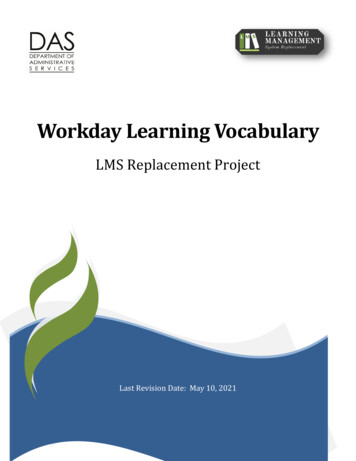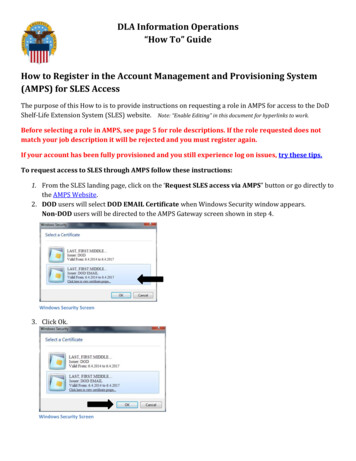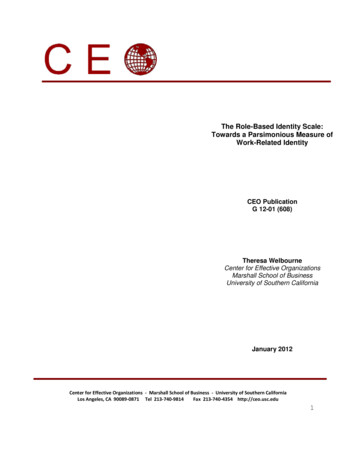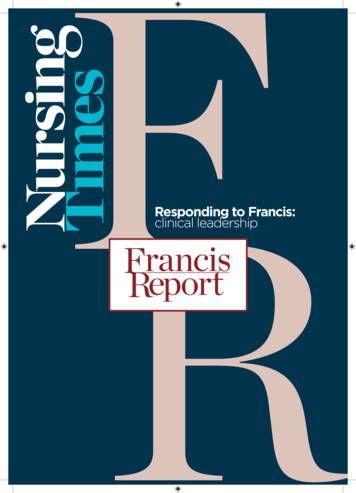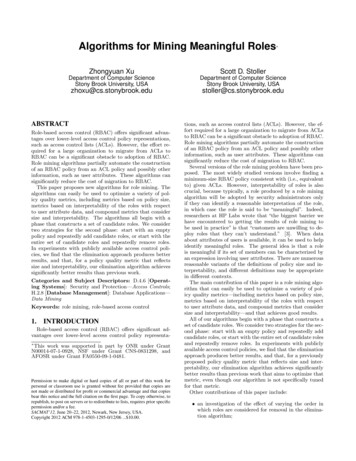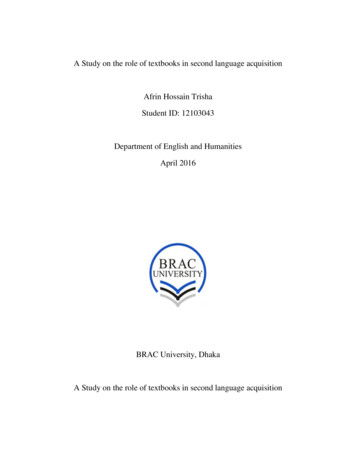
Transcription
A Study on the role of textbooks in second language acquisitionAfrin Hossain TrishaStudent ID: 12103043Department of English and HumanitiesApril 2016BRAC University, DhakaA Study on the role of textbooks in second language acquisition
IIA thesisSubmitted to the Department of English and HumanitiesOfBRAC UniversitySubmitted byAfrin Hossain TrishaStudent ID: 12103043In partial fulfillment of the requirements for the degree ofBachelor of Arts in EnglishBRAC University, DhakaApril 2016
IIIDedicationI want to dedicate this paper to my parents who encouraged me and gave me unconditionalsupport and love.
IVDeclarationI certify that the dissertation I submitted is my original work. I am also conscious about the factthat there is no such resources used for which my work can be found to be plagiarized. If I usedany resources, I gave references for those.Signature
VAcknowledgementFirstly, I want to thank my Almighty who gave me patience and strength to complete my thesispaper. Secondly, I want to convey my sincere gratitude to my supervisor Mohammad MahmudulHaque who gave me the proper guidance. He supported and motivated me with his immensepatience all the time during my thesis writing and made possible to complete my thesis paper.Besides my supervisor, I also want to express my heartily thanks to some of my close friends,who encouraged me a lot in my thesis. Last but not the least, my sincere thanks also go to myparents and husband with whose collaboration, motivation, and inspiration it has becomepossible to complete my thesis.
VIAbstractThe purpose of this study was to find out the importance of textbook in second languageacquisition. This study attempted to find out the roles a textbook can play in second languageacquisition and how important a textbook is for second language acquisition and teaching aswell. Moreover, this study also attempted to find the ways through which textbooks can beeffectively used for second language acquisition. To find out these things, the researcher didsurveys in English medium schools. It has analyzed the surveys or the answers or responds ofquestionnaires by using pie charts and following quantitative method. This research alsoprovided the recommendation which can help teachers in terms of selecting and adapting booksfor teaching second language and also using authentic materials for better learning from books,so that students can gather pure knowledge and information about second language throughtextbooks. There is no research which is free from limitations; similarly this research also facedlimitations. By overcoming obstacles and limitations, this study finally became capable to findout the answers of research question.Key words: Second language acquisition, positive and negative role of textbooks in languagelearning, other sources that can replace textbooks for language learning, effective use oftextbooks.
VIITable of ContentDedication IIIDeclaration .IVAcknowledgement .VAbstract . VIChapter 1 . 1Chapter 2 . 32.1 What is Second Language Acquisition . 32.2Relationship between textbook and language acquisition 42.3Role of textbook in the acquisition of second language .6 2.3.1Balance among the four skills .62.3.1. (A) Develop sentence formation and vocabulary skills (reading Perspective) 62.3.1. (B) Textbooks promote writing 72.3. 1. (C) Develop communication and listening skill 82.3.2 Guideline for teachers .92.3.3Textbooks give a specific curriculum in English language learning .102.3.2. Layout and design of textbook 112.4Limitations of textbook regarding second language acquisition .112.4.1. Internet has decreases the role of textbook in language learning 122.4.2. Textbook learning causes boredom and de-motivates students and teachers 122.4.3. Students are more attracted by audio visual materials rather than textbook .142.4.4. Cultural impact of textbooks on second language acquisition .14Chapter 3 163.1. Research design 16
VIII3.2. Participants .163.3. Instrumentation 173.4. Setting .183.5. Data collection procedure .183.6. Methods of analysis .193.7. Limitations of the study .20Chapter4. .214.1 Findings of Questionnaire 21Chapter 5. .345.1 Discussion . .345.2 Conclusion . .375.3 Recommendation. .37Works Cited . 41Appendix. .45
Running head: THE ROLE OF TEXTBOOK IN SECOND LANGUAGE ACQUISITION1The role of textbooks in second language acquisitionChapter 1Introduction:Language is an important medium to communicate or interact with others. At presenttime, language learning is not only limited to our mother tongue. Our thirst of knowing hasflourished day by day and we are starting to learn more than one language for our own sake ofinterest. We know that second language learning is not as easy as our first language. It requiresmore times, concentration and good materials. Textbook is a kind of material that plays veryimportant role in teaching and learning process. It includes knowledge, guideline, contents,information etc. It is a readymade and useful material. There is no such educational institutionwhere we cannot see any use of textbook. However, according to (Nilsson, 2006), learning styleis very important for students to acquire or learn new knowledge orinformation, but in thepresent days most of the students are not aware of their own learning style and it is also true thattextbooks play as a starting point for every learners who even follow different learning styles, butlanguage learning based on a textbook can makes student feel good because they can have a nicestructure to follow.Textbook has some disadvantages too. The relationship between textbook andlanguage teaching and learning is not a recent issue and there are lots of debates on this issue thatwhether textbook can actually play any role on language learning or not. Textbooks are preparedfor language learning purpose and it aims that student will learn language “as a system” and oncethey learned it, they will be able to use language in their own style, according to (Grant,1990).This paper aims to represent how important a textbook is for second language acquisition.
2THE ROLE OF TEXTBOOKS IN SECOND LANGUAGE ACQUISITIONThe researcher has seen that in schools, students and teachers both completely depends ontextbook for English language learning. In addition to this, Mohamed (2015) said that, for schoolchildren, textbooks play a very powerful role that it can manipulate the students‟ way ofthinking. In short, importance of textbook can be described as – it plays as a primary toolprovided by the school which allows the students to gather knowledge and practice the skills thatthey are expected to learn.
3THE ROLE OF TEXTBOOKS IN SECOND LANGUAGE ACQUISITIONChapter 2Literature review:This section illustrates how textbooks play an important role in students‟ second languageacquisition and what are the areas where textbook cannot play better role. This section willconcern about the fact that whether textbook is really necessary in learning English language ornot.Many theories and methodologies have been provided by the scholars about secondlanguage acquisition. Nowadays modern technology such as internet, computer, television, socialnetworking cites and other sources such as- audio- visual materials, interaction, communicationwith others, etc. create a lot of opportunities for learning and using English language. This makespeople get away from textbook. Though textbook has some hindrances but it is also true thattextbook and language learning has a very strong relationship. Before going to the relationshipbetween textbook and second language acquisition, we must know what second languageacquisition is.2.1 What is Second language acquisition?A second language is a language that is learned in addition to a person's mother tongueor first language. Ellis (1985) claimed that, “SLA is not a uniform and predictable phenomenon”.He further said that, second language acquisition does not follow any specific process and it‟s acombination of multiple processes. He also stated that this language acquisition “covers thedevelopment of phonology, lexis, grammar and pragmatic knowledge”. However, we can seevarieties of materials has been developed for language learning but in some specific cases, we
4THE ROLE OF TEXTBOOKS IN SECOND LANGUAGE ACQUISITIONcannot deny the use of textbook for English language acquisition because it provides “ageappropriate materials” whereas, there is no appropriate level mentioned in other sources oflanguage learning (The great textbook debate: The role of textbook in World language, 2013). Inaddition to this, Krashen, Stephen D, Terrell and Tracy D (1983), have talked about natural orderhypothesis. According to them, “natural order is based on the theory that language acquisitionoccurs only when students receive comprehensible input”. So in that case, textbooks which areappropriate for a certain age of students will be comprehensible for the students of that certainage rather than any other sources and this proves that second language acquisition has a verystrong relation with textbook.2.2. Relationship between textbook and second language acquisition:When everyone is attracted towards the technology based learning nowadays, it is veryimportant to know the relationship between textbook and language acquisition. According toJohnson (2011), whenever young students want to find out some information, they search it oninternet but if they want to check something factual, it‟s important to see it in a book. Hisstatement clearly states that, the way a book can contain correct information, no other sourcescan provide this accurately. In addition to this, Schultan (2013) stated that, Truth has never beenan essential ingredient of viral content on the Internet, which means what is given there in onlineis not always true and accurate. Furthermore, Bahar, Zaman (2013) added that, “textbooksperform a very significant role in language teaching and acquisition as well”. Similarly, Richard(2012) stated that, English language textbooks provide a lot of activities which help in Englishlanguage teaching and learning. He also added that, textbooks are preferable for EFL classroomwhen it will contain “authencity of language” and “the representation language that theyprovide” (p. 2). Authentic texts are really good for language learning and there are a lot of
5THE ROLE OF TEXTBOOKS IN SECOND LANGUAGE ACQUISITIONarguments about authentic text but in 1994, Taylor has established an argument that authenticityof language means- a raw material or a text which is related with real life and can be used as aninput data for learners (cited in Lotz and Russo, 2006). Selection of good textbooks can actuallyrepresent a good number of authentic texts to the students. For example, Lightbrown and Spada(2006) gave an example in their book about affective filter hypothesis in their book. There is apicture given that a girl is getting nervous to see lots of books in front of her. (p. 37). So thisscene or situation is comprehensible for the students and very much relatable with their real life.Furthermore, Richard (2012) again stated that textbooks are a key component for any languageprogram. With the help of textbook students will learn the approach to use language forcommunication purpose rather than following the structure, (Donough and Shaw, 2003).Moreover, Textbooks provide a short idea to the students on the content; it serves the basis oflanguage input and creates a balance among the four skills. Before learning any new things(language), we need a proper structure, syllabus or guideline that can show us the properdirection. In addition to this, Cheng, Hung and Chieh (2010), stated about textbooks that it givesa guideline for learning or teaching English. However, along with the students, teacher‟sproficiency in teaching has also been considered as an important part of successful Englishteaching (Butler 2004). A teacher‟s most important job is perhaps to create the conditions inwhich learning can take place (Scrivener, n. d). In that case textbooks can be one of the bestelements for engaging the students into the target language.
6THE ROLE OF TEXTBOOKS IN SECOND LANGUAGE ACQUISITIONThe researcher has selected some factors which show that textbooks are really importantin second language acquisition:2.3. Role of textbook in the acquisition of second language:2.3.1. Balance among the four skillsThe skills of English language are the pillars or central part of that language. There arefour skills in English language and these four skills are interrelated with each other. It is veryrare to see people practice one skill separately. Usually people practice two or more skillstogether according to Hossain (2009). Textbook is such a source through which students canpractice two or more skills together.(A). Develop sentence formation and vocabulary skills (reading Perspective)Vocabulary: According to Kit U (2009), book reading increases learners‟ engagementwith the topic. Moreover, they will be able to develop their vocabulary skills. According toCunningsworth(1995: 38), communication in English language is impossible without knowledgeof good number of vocabulary. So, in that case, only textbooks can help students to develop theirvocabulary skills. Similarly, Eccleshare (2013) added that, if students read books for theirpleasure, they will acquire a good number of vocabulary, they will be able to absorb simple orsometimes complex sentence structure as well without giving any conscious effort. Moreover,she also said that, some of them become “a very good speller (not perfect)”. Furthermore,Hossain (2009), added that, textbooks help students to learn some strategies so that they can dealwith the new and unfamiliar words easily. . In addition to this, Lowry (2014), stated that, onlylearn a new word cannot make anyone‟s vocabulary strong. He said that, learning words become
7THE ROLE OF TEXTBOOKS IN SECOND LANGUAGE ACQUISITIONeasy meanings are comprehensible to students. He further added that, if students can understandthe meaning of new words, they will be able to use it in different sentences according to thecontext.Grammar: According to Cunningsworth, (1995: 32), for learning any language,grammar is considered as “a major component”. It makes the students able to “create their ownutterances” and to use language appropriately. Grammar works as a basic foundation for anylanguage learning. Kit U (2009) has stated that if a student can engage himself/ herself intoreading textbooks then he/ she will be able to relate grammatical structure with the sentenceswritten in the textbooks, that student do not has to memorize the structure. However, to engagestudents in reading textbooks, Davis (1995) stated that textbooks should be selected according totheir attractiveness and it should have “relevance to the pupils‟ lives rather than for literarymerit”. This will encourage them to read more books (p. 329). However, according to Walter,learners can build speed and fluency by learning vocabulary systematically and by doing lots ofeasy („extensive‟) reading. On this matter, Krashen (1982) established an argument that- thistype of reading always promotes language acquisition with interesting material and a tension freelearning environment. Basically it provides comprehensible input to the students. According toGathercole and Baddeley, (1995) the more the students will read textbooks; it will help them torepresent structured sentences in the target language without being aware about the structure butit makes students aware of the use of making correct sentences.(B). Textbooks promote writing:According to, Stosky (1983) and Krashen (1984), reading textbooks also promoteswriting because students who are “prolific” readers can also represent their good writing ability.In addition to this, Warren (2009), stated that, textbooks can help a lot in creative writing, essay
8THE ROLE OF TEXTBOOKS IN SECOND LANGUAGE ACQUISITIONwriting, constructive analysis writing etc. because learners can get idea about their writing topicfrom textbook, moreover they can bring literature in writing with the help of textbook. Sincereading and writing have a connection between them so “writing can affect reading and readingcan affect writing” (relationship between reading and writing, n.d.). Since it has been statedabove that, reading textbooks help students in developing their vocabulary and grammaticalstructures, so when students get ready for produce anything (writing), their knowledge of richvocabulary and grammatical structure will help them a lot to produce a good structure in writing.However, Textbooks also promote writing by taking notes from teacher‟s talk or lecturesaccording to Hossain (2009). Sometimes teachers do not give that much information about aparticular chapter because they want the students to get involve with the course book by readingand this promotes taking notes from the chapter (how to take notes from textbook, n. d).(C). Develop communication and listening skill:Communication: According to Warkick(2010), textbook provides some activities suchas conversational passage; pronunciation drill etc. can help in developing students‟communication skill. Furthermore, Mcdonough and Shaw (2010) have stated that, textbooks helpstudents to learn the approaches of English language that they can use for communication. In thatcase, students will avoid memorizing the structures and will learn the actual use of language forreal life communication. Students can be introduced with new words and how same word can bedifferently used in different sentences with the help of textbook according to Lawry (2014). Healso added that, textbooks provide some imaginary or unfamiliar words (such as- prince,princess, pirates etc.) which help students to think and discuss about them which can promotespeaking in target language.
9THE ROLE OF TEXTBOOKS IN SECOND LANGUAGE ACQUISITIONListening skill: It is the most challenging part for textbook to develop and practicelistening skill. Listening to the teacher‟s lecture can be a practice for listening skill. Moreover,some supplementary activities done by the teachers can also help in developing listening skills.For example, some exercises such as true/false, fill in the blanks, answer in one word these canbe done by some audio materials provided by textbook as a supplementary material to developstudents‟ listening skill (the essentials of language teaching n. d).2.3.2. Guideline for teachers:According to O‟Roark (2001), “a textbook is an essential starting point for education in a foreignlanguage classroom”. Moreover, Kayapiner (2009) added that, coursebook or textbook is verymuch popular among teachers because it provides a particular objective of learning. He furtheradded that, it also provides a balanced content for which a consistency always remains amongthe topics “in four skill areas, (listening, speaking, reading and writing)”. However, Moulton(1994) stated that, when teachers focus on textbooks, they give most priority on the quality andcontent of the books. Format--and appropriateness of the books is also a matter of concern sinceit is important for the students in terms of their level of vocabulary. In addition, in somesituations, the textbook may function as a supplement to the teachers‟ instruction in the ESLteaching and learning process, according to (Noordin and samad). Similarly,A. Woodward(1987:511) claims that teachers find it difficult and impossible sometimes, to teach and giveinstructions to the students without the help of textbooks and teachers guides. On the otherhand,Bruner (2015), has given a very important statement about selecting textbook – heconsidered textbook selection as a serious business. It involves an expenditure of considerablefunds, and “you will be "stuck" with the book you choose for years”. In addition to this, Kramsch(1988) added that, once there was a time when textbook was used as the “bible” or “instruction
10THE ROLE OF TEXTBOOKS IN SECOND LANGUAGE ACQUISITIONguidebook”. Instructors had very little time for supplementary items or adaptation of books. Inthat case Lenon (2015), added that still now if the people above 40 age being asked about thetextbook of their times, they will be easily say the topics with the page number. He also statedthat during that time, they used to learn English only from textbooks.2.3.3. Textbooks give a specific curriculum in English language learning:Without a textbook learners may not get a specific syllabus “that has been systematicallyplanned and developed” and a “central core” of learning said Richard (2009). He also added that,textbooks maintain quality and without textbook stages of learning cannot be specified. So, if atextbook which maintains the quality can be chosen for the learners, it can provide not only thebookish knowledge but also some variety of resources such as- “CDs and cassettes, videos, CDROMs and a comprehensive guideline for the teachers as well”. According to O'Roark (2001),people usually want to learn a second language so that they can be able to communicate withpeople in the target language and when a student acquires a second language, he/she ensures thatthis ability will stays permanently with him. So, it is important to use a textbook that will mosteffectively allow a student to become interested in and comfortable with their second language.According to Stephen Krashen, language acquisition does not means extensive use of consciousgrammatical rules, and “does not require tedious drill”. He also added that meaningfulinteraction in the target language is enough to learn a new language. In that case, selectingappropriate material or textbook can play an important role. According to Graves (2000), hasstated that in terms of selecting textbooks, teachers can play a very important role. they can readthe table of content and evaluate them to justify whether the textbooks can meet the students‟need or not and then according to the evaluation, they can adapt the textbook which requires a
11THE ROLE OF TEXTBOOKS IN SECOND LANGUAGE ACQUISITIONlittle bit modification or they can use the books as it is (p. 176). Jim Scrivener has given in hisbook “learning teaching” many activities which requires interaction and communication in targetlanguage. The activities that are given in the book- group discussion and classroom interaction inthe target language. These activities will promote speaking and listening opportunities in thetarget language. On the other hand learning and teaching can be specified with the help of acurriculum that explains how the teacher will accomplish this and techniques or daily strategiesfor teaching (Brown, 57).2.3.4. Layout and design of textbook:It is already mentioned above by Davis (1995), that textbooks should be selected“according to their attractiveness”. Similarly, Sheldon (1988: 243) added that, textbooks thosehave a mix of graphical material and text can provide comprehensible input to the students andmake them attracted towards the book.2.4. Limitations of textbook regarding second language acquisition:Haseldon (2011) said that nowadays people are getting away from books, “whichis a shame”. Though foreign language textbooks serve the stages for methodological approachesbut students get confused that which methodology they should follow since different textbookstalks about different methodologies, according to Harlen (2000). Moreover Lenon (2015) hasrepresented the comment of Richard Culatta (the US department for education). He said that,when books become outdated it is difficult and time consuming to update the books while inwebsites it is easier to update the information.Furthermore, Meyers (n. d), contended that, bookscan only cover a limited area of a language. Further, these books are sometimes expensive to buy
12THE ROLE OF TEXTBOOKS IN SECOND LANGUAGE ACQUISITIONwhereas with the help of internet a huge area can be covered and many resources can be foundall together. He also added that, one textbook will contain the thought of only one writer,whereas, through internet students can get a lot of writers‟ thoughts together within few hours.2.4.1. Internet has decreases the role of textbook in language learning:Technologyhas made the language learning easy for the students. According toWarschauer (2000), World Wide Web offers a “vast area of resources”. He further added that,since internet is a vast medium, it can replace textbooks and libraries. Moreover, Motteram(2013) claimed that, computer based learning help learners to work individually and it also helpsthem not only in learning language but also work with the target language. He also added that, italways encourages students to learn things through language. However, according to Kasanga(1996), because of internet, second language acquisition has been increased among students.Additionally, internet helps students to interact with foreign language speakers and help them topractice in real life situation such as- negotiation, discussion, chatting etc. according to (LeLoupand Ponterio, 1997) which textbook lacks. According to singhal (1997), online learning gives theopportunities of creative presentation such as essays, poetry, stories etc. to the students.However, “lack of motivation is a major cause for students not learning a second languageproficiently” according to Toussaint (2005). In that case, internet plays a great role to stimulatesecond language acquisition. Students show interest in using technology and computers foracquiring second language.2.4.2. Textbook learning causes boredom and de-motivates students and teachers:Sometimescourse books cause boredom because students and teachers get bored of usingthe same material and content everyday and there are less opportunities of variation. According
13THE ROLE OF TEXTBOOKS IN SECOND LANGUAGE ACQUISITIONto Charalambous (2011), textbook centered teaching cannot make class interesting because itleads to “dull and repetitious classes” and makes students de motivated to learn. Since individuallearner has their own learning style, for each student, textbook may not be that much helpful.Farooq (2011) said about individual learning style that according to dictionary of educationIndividual differences are those differences which exist among humans and make a single persondifferent from another person. He also added that these differences generally occurs based oninterest, attitude, values, habits, psychomotor skill, self concept. In addition, Wang and Lindvall(1984) also proposed that a learner responded to the environment according to his individuallearning style and in a learning environment teacher‟s instruction is an important media tofacilitate appropriate responds from a student.Some students are motivated by audio visualmaterials, such as- movies, youtube videos, cartoons, songs etc. According to Lightbrown andSpada (2006), second language acquisition occurs better when students get some motivation,(p.185). So students can learn better from the materials which motivate them. In fact use oftextbook as an only teaching material can makes the teaching boring and controlled processwhich hampers teacher‟s creativity according to Richard, (1993). Moreover, Allwright, (1981:8)argues that, textbooks makes the teachers‟ role limited and that is why, teachers do not getencouraged to give enough input to the students. He also added that, textbook holds a verylimited and prescribed role which does not involve students‟ participation. To support thisstatement, Charalambous (2011), stated that, if students can actively participate in their ownlearning that will help them to learn more. He also stated that, teaching same type of activity andtopics does not create any good respond from students and makes the learning and teachingboring.
14THE ROLE OF TEXTBOOKS IN SECOND LANGUAGE ACQUISITION2.4.3. Students are more attracted by audio visual materials rather than textbook:According toÇAKIR (2006), in recent years, the tendency to use technology ineducational sectors has gained a great importance. Mostly in the case of technology the use ofvideo is very much popular among students. Moreover, he also added that, video helps a lot insecond language learning since it “stimulates and facilitates about the target language”.According to Wright (1976:1) many media and many styles of visual presentation are really veryhelpful for the language learners because “all audio-visual materials have positive contributionsto language learning” but these have to be used in the right situation and in the right time.ÇAKIR (2006) again stated that, video is very much accepted by students rather t
textbook and language learning has a very strong relationship. Before going to the relationship between textbook and second language acquisition, we must know what second language acquisition is. 2.1 What is Second language acquisition? A second language is a language that is learned in addition to a p



